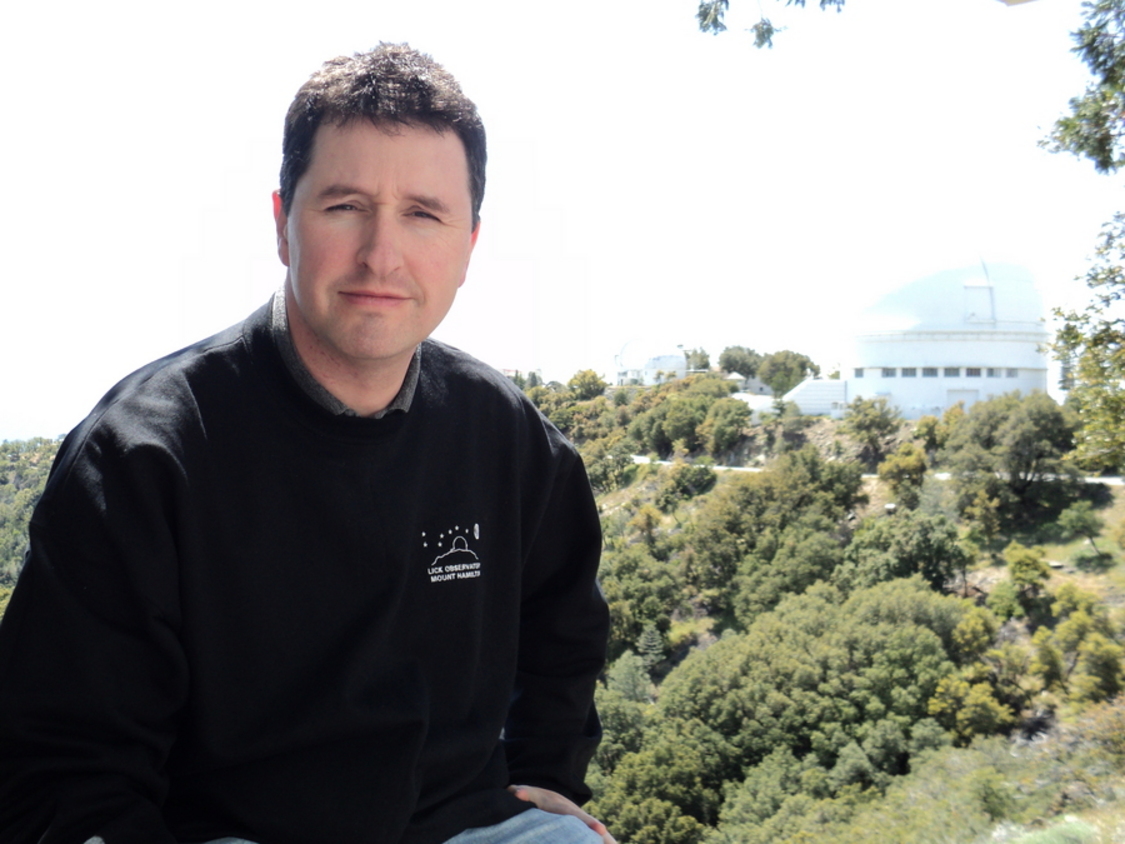About | Disclaimer | Modifications
Paul Lynam is a resident astronomer at Lick Observatory1, a multi-campus research unit of the University of California2, providing state-of-the-art research facilities. Opened in 1888 as part of the legacy of James Lick, the world's first high altitude astronomical observatory overlooks San Francisco Bay from the (4200 ft / 1280 m) summit of Mount Hamilton, East of San Jose. University of California Observatories (UCO3) administrative headquarters are based at the University of California Santa Cruz (UCSC4) campus. An amateur astronomer since childhood, undergraduate (B.Sc.) studies of physics with astronomy at the University of Central Lancashire (UCLan5, UK) were followed in 1995 by research and thesis leading to a masters (M.Sc.) degree in physics at the University of Kent at Canterbury (UKC6, UK). This work investigated the effect of meteoroids on space platforms. It informed operators (e.g. NASA7) to modify on-orbit operations of (among others) the Hubble Space Telescope (HST) and Space Shuttle. Within the Space Sciences Unit, data analysis from missions such as HST, the Giotto probe to comet 1P/Halley and NASA's Long Duration Exposure Facility was on-going. Simultaneously, preparatory work for the Cassini-Huygens (Titan, 2005) and Rosetta-Philae (comet 67P/Churyumov-Gerasimenko, 2014) landers was underway. In 2000, a Ph.D. in astrophysics was awarded by Liverpool John Moores University (JMU8, UK), based on work involving Brightest Cluster Galaxies and the search for 'cosmic flows'. A three year stipend was then spent at the Max-Planck-Institute for Extraterrestrial Physics (MPE9, Germany), further exploring the properties of giant galaxies, clusters of galaxies and the large-scale structure of the Universe, before a move to the headquarters of the European Southern Observatory (ESO10, Germany). A Chile-based ESO fellowship, including supporting operations of the world's most advanced ground-based observatory, the Very Large Telescope (VLT) at Cerro Paranal11 followed between 2004 and 2008. Duty continued as an operations astronomer at Paranal in 2009 and 2010, These observatory support roles place astronomers 'in the room where it happened' for landmark events (e.g. the first image of an exoplanet; watching the black hole at the heart of the Milky Way). In 2011 Paul Lynam joined Lick Observatory, bringing over five years (500+ nights) of observatory experience and a working familiarity with many modern astronomical techniques - some of which have been deployed during 100+ nights as a visiting research astronomer, attending other leading observatories (e.g. Mauna Kea12, La Palma13, La Silla14, South African Astronomical Observatory15). Research interests are mainly extragalactic. A regular contributor to teaching and public outreach activities, Paul Lynam supports DarkSky International (formerly the International Dark-Sky Association, IDA)16), is a Member of the International Astronomical Union (IAU17), the Institute of Physics (IoP18) and a Fellow of the Royal Astronomical Society (RAS19).References
1. Lick Observatory: https://www.lickobservatory.org; http://mthamilton.ucolick.org;2. University of California: http://www.universityofcalifornia.edu.
3. Mount Hamilton: http://www.ucolick.org; https://www.ucobservatories.org. Information Leaflets: Simple; Graphic.
4. University of California Santa Cruz, UCSC: http://www.ucsc.edu.
5. University of Central Lancashire, UCLan: http://www.uclan.ac.uk.
6. University of Kent at Canterbury, UKC: http://www.kent.ac.uk.
7. National Aeronautics and Space Administration, NASA: http://www.nasa.gov.
8. Liverpool John Moores University, JMU: http://www.ljmu.ac.uk.
9. Max-Planck-Institute for Extraterrestrial Physics, MPE: http://www.mpe.mpg.de.
10. European Southern Observatory, ESO: http://www.eso.org.
11. Paranal Observatory: http://www.eso.org/public/teles-instr/vlt.html.
12. Mauna Kea Observatories, MKO: http://www.ifa.hawaii.edu/mko/.
13. Instituto Astrofisica de Canarias, IAC: http://www.iac.es/index.php?lang=en.
14. La Silla Observatory: http://www.eso.org/public/teles-instr/lasilla.html.
15. South African Astronomical Observatory, SAAO: http://www.saao.ac.za.
16. DarkSky International (formerly the International Dark-Sky Association, IDA): http://www.darksky.org.
17. International Astronomical Union, IAU: https://www.iau.org/administration/membership/individual/20556/.
18. Institute of Physics, IoP: http://www.iop.org.
19. Royal Astronomical Society, RAS: http://www.ras.org.uk.
